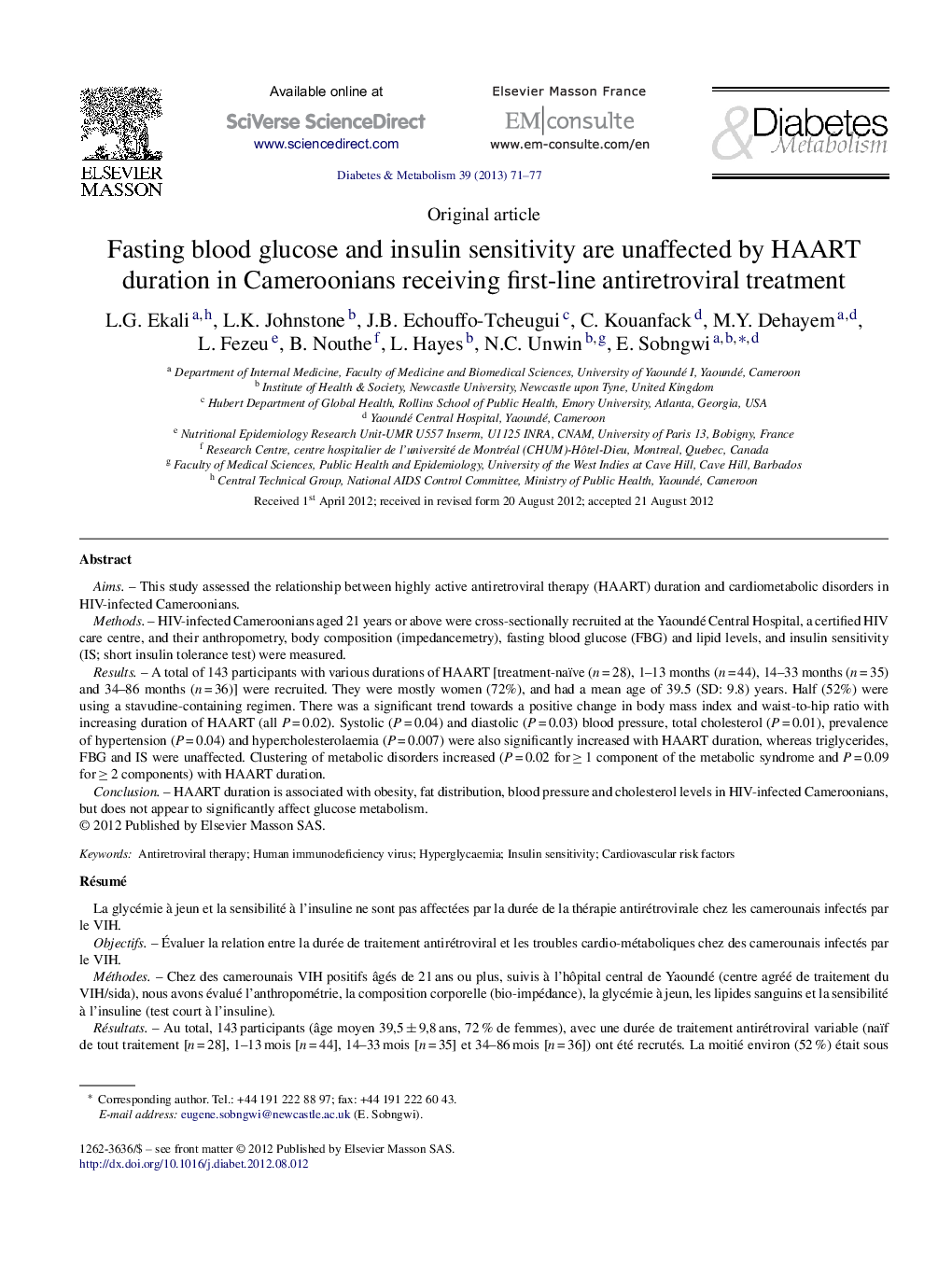| کد مقاله | کد نشریه | سال انتشار | مقاله انگلیسی | نسخه تمام متن |
|---|---|---|---|---|
| 3259974 | 1207599 | 2013 | 7 صفحه PDF | دانلود رایگان |

AimsThis study assessed the relationship between highly active antiretroviral therapy (HAART) duration and cardiometabolic disorders in HIV-infected Cameroonians.MethodsHIV-infected Cameroonians aged 21 years or above were cross-sectionally recruited at the Yaoundé Central Hospital, a certified HIV care centre, and their anthropometry, body composition (impedancemetry), fasting blood glucose (FBG) and lipid levels, and insulin sensitivity (IS; short insulin tolerance test) were measured.ResultsA total of 143 participants with various durations of HAART [treatment-naïve (n = 28), 1–13 months (n = 44), 14–33 months (n = 35) and 34–86 months (n = 36)] were recruited. They were mostly women (72%), and had a mean age of 39.5 (SD: 9.8) years. Half (52%) were using a stavudine-containing regimen. There was a significant trend towards a positive change in body mass index and waist-to-hip ratio with increasing duration of HAART (all P = 0.02). Systolic (P = 0.04) and diastolic (P = 0.03) blood pressure, total cholesterol (P = 0.01), prevalence of hypertension (P = 0.04) and hypercholesterolaemia (P = 0.007) were also significantly increased with HAART duration, whereas triglycerides, FBG and IS were unaffected. Clustering of metabolic disorders increased (P = 0.02 for ≥ 1 component of the metabolic syndrome and P = 0.09 for ≥ 2 components) with HAART duration.ConclusionHAART duration is associated with obesity, fat distribution, blood pressure and cholesterol levels in HIV-infected Cameroonians, but does not appear to significantly affect glucose metabolism.
RésuméObjectifsÉvaluer la relation entre la durée de traitement antirétroviral et les troubles cardio-métaboliques chez des camerounais infectés par le VIH.MéthodesChez des camerounais VIH positifs âgés de 21 ans ou plus, suivis à l’hôpital central de Yaoundé (centre agréé de traitement du VIH/sida), nous avons évalué l’anthropométrie, la composition corporelle (bio-impédance), la glycémie à jeun, les lipides sanguins et la sensibilité à l’insuline (test court à l’insuline).RésultatsAu total, 143 participants (âge moyen 39,5 ± 9,8 ans, 72 % de femmes), avec une durée de traitement antirétroviral variable (naïf de tout traitement [n = 28], 1–13 mois [n = 44], 14–33 mois [n = 35] et 34–86 mois [n = 36]) ont été recrutés. La moitié environ (52 %) était sous une combinaison thérapeutique incluant la stavudine. Nous avons observé une tendance à une augmentation significative de l’indice de masse corporelle (IMC) et du rapport taille–hanche avec la durée de traitement antirétroviral (P = 0,02 dans les deux cas). Les pressions artérielles systolique (P = 0,04) et diastolique (P = 0,03), le cholestérol sanguin (P = 0,01), la prévalence de l’hypertension artérielle (P = 0,04) et de l’hypercholestérolémie (P = 0,007) étaient significativement augmentés avec la durée du traitement antirétroviral. Les triglycérides, la glycémie à jeun et la sensibilité à l’insuline n’étaient pas modifiés par la durée du traitement antirétroviral. Une accumulation de troubles métaboliques (P = 0,02 pour au moins un facteur de risque, P = 0,09 pour au moins deux facteurs de risque) avec l’augmentation de la durée du traitement antirétroviral a également été observée.ConclusionLa durée du traitement antirétroviral est associée à l’IMC, la redistribution de graisses, l’hypertension artérielle, la dyslipidémie chez les sujets camerounais séropositifs pour le VIH. Cependant, elle ne paraît pas avoir d’effet sur le métabolisme glucidique.
Journal: Diabetes & Metabolism - Volume 39, Issue 1, February 2013, Pages 71–77